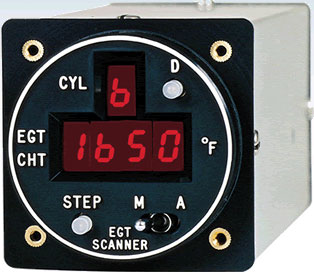 There are analog dials, there are digital scanners and then there are classic scanners – each better than the previous. All these dials and scanners are used in modern aircraft to provide engine related information to the pilot(s). There are analog dials, there are digital scanners and then there are classic scanners – each better than the previous. All these dials and scanners are used in modern aircraft to provide engine related information to the pilot(s).
Let’s say as a pilot flying an aircraft, you wanted to know the Exhaust Gas Temperature (EGT). You could do it the old-fashioned way by installing an analog dial EGT gauge or, you can do it the modern way by installing a digital scanner.
A typical scanner (depending on its sophistication), is paired with one or more sensors / probes e.g. EGT and CHT probes. Each of these sensors or probes in turn, is plugged into different parts of the aircraft engine. These sensors (or probes) send back data to the scanner. The scanner displays the data on a small screen. Also, a scanner (again depending on its level of sophistication), may also have buttons on the face-plate to facilitate menu selection.
Classic scanners as manufactured by J.P. Instruments of U.S.A, represent State-of-the-art technology and most of their models are capable of audio-visual indicators. The alarm is triggered when incoming data is at variance with factory set parameters - for example (depending on the scanner), low RPM Sensor or low fuel or high temperature and so forth.
Generally, most pilots/aircraft owners tend to buy a classic scanner when they need to replace an existing analog gauge. Instead of replacing it with another analog gauge, they upgrade to a classic scanner.
The J.P. Instrument manufactured Classic Scanner is a small convenient package with an even more convenient price tag. It was first introduced 20 years back and has since been continuously upgraded. Over the years it has proved its reliance, accuracy and durability.
Economical to buy and easy to install and use, the Classic scanner has large red LED display that makes it very easy to read in all weather and light conditions.
Flawlessly accurate, the Classic Scanner is paired with JPI’s famous super accurate fast-response . The Scanners are FAA TSO approved (Aerospace Standard AS 8005 and RTCA Documentation DO160A) and comes with a one-year limited warranty.
The J.P.I. Classic Scanner comes equipped with a ‘dimming’ switch located on the top of the scanner. Each press alternates between bright and dim. The EGT – CHT classic scanner has a hole on the bottom of the scanner. The pilot can use a screwdriver to easily increase the number channels scanned (up to 8) in an Aircraft Engine Monitoring Systems.
Different models have functionality and features depending on the speciality of that particular scanner. For example, in the case of above mentioned EGT-CHT classic scanner, the pilot can alter the indexing rate. This model also comes equipped with a visual alarm that is triggered at 450°F (for CHT) and 1650°F (for TIT). Knowing that the scanner will alert the pilot in case of any abnormality, the pilot needs no longer watch the EGT – CHT and instead, can enjoy the flying.
For more information on Classic Scanners, please visit: https://www.jpinstruments.com/shop/classic-scanner/
|